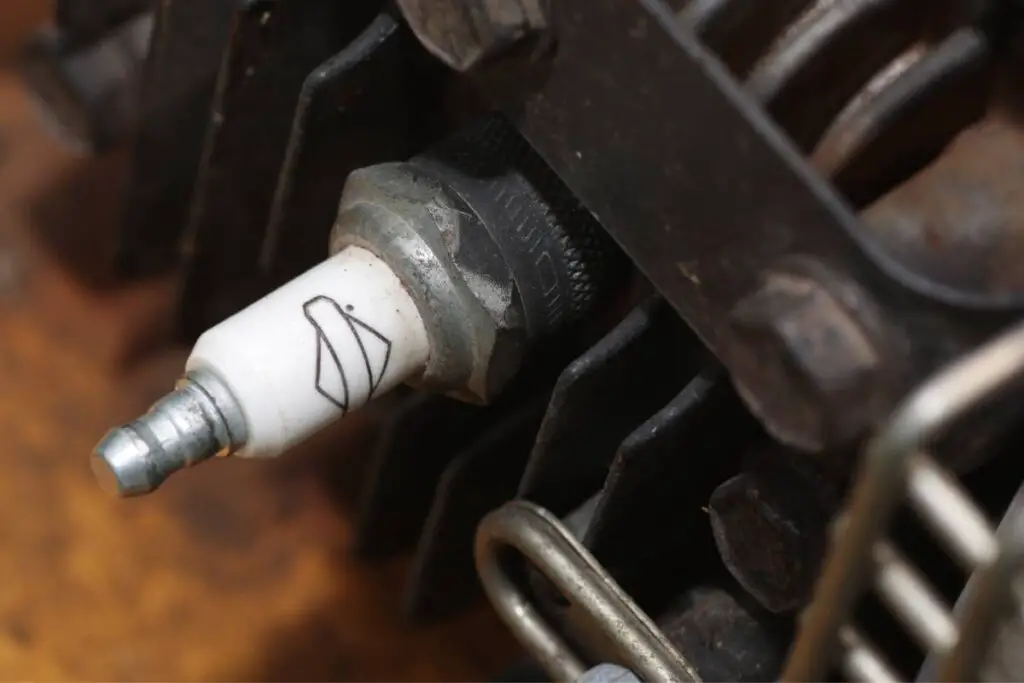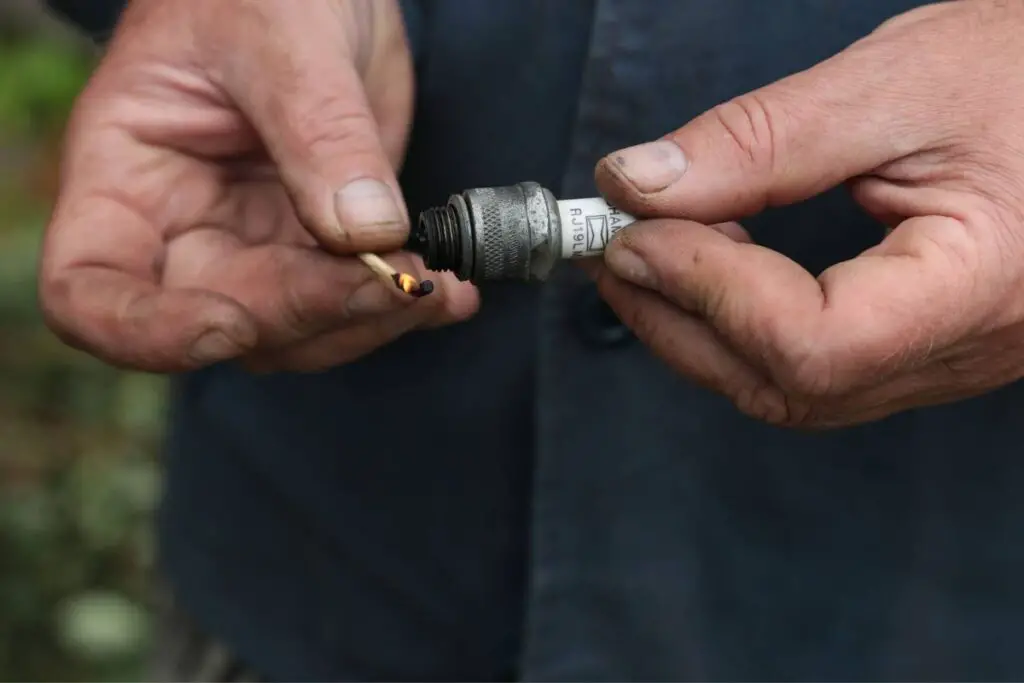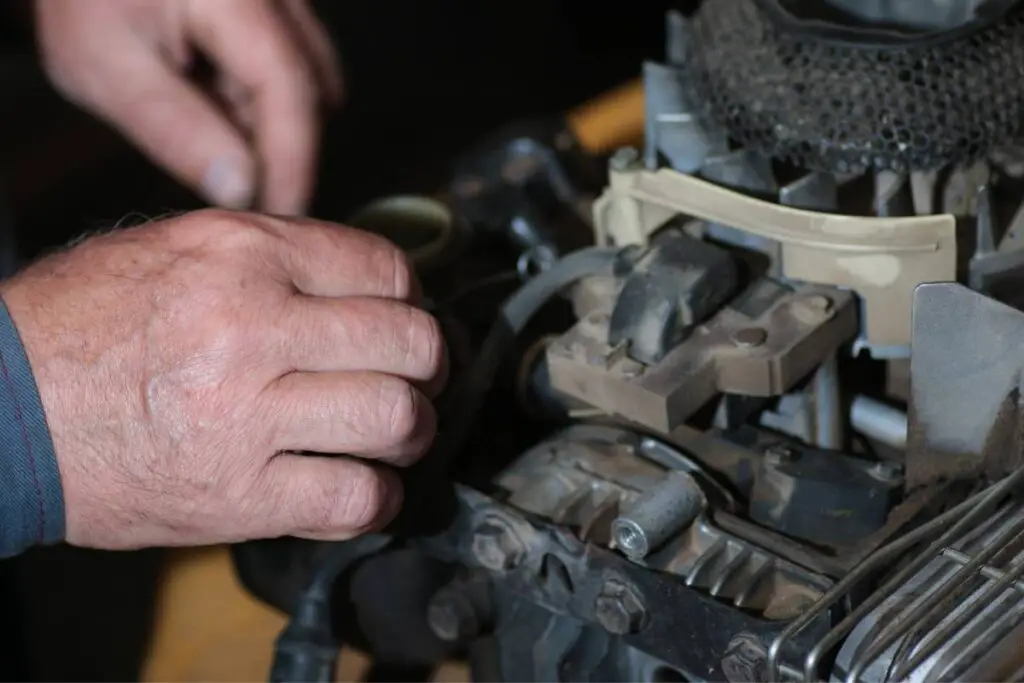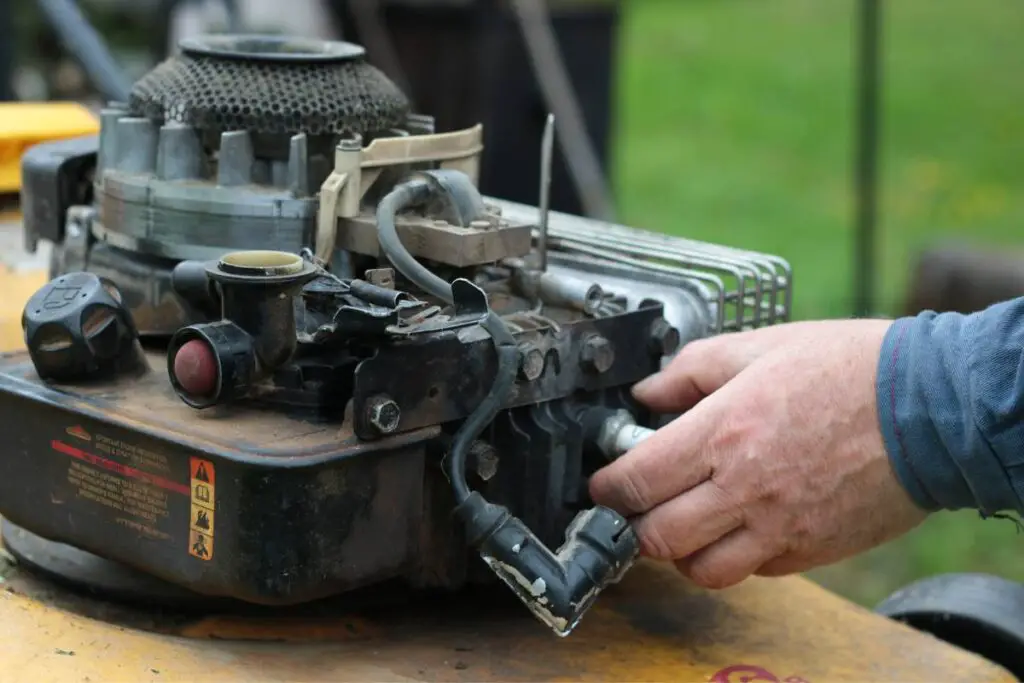A lawn mower without sparks, when needed, can be frustrating. Without the spark, the mower will not start working. So, it becomes essential to find out the reasons behind the no sparks and solve them quickly to get it to run.
If there are no sparks in the lawn mower, reasons could be spark plug faults, plug wire faults, stop or start assembly faults, coil air gap, corrosion in the flywheel, loose or misplaced flywheel magnets, or grounded coil or flywheel. Sometimes, lack of gas doesn’t allow sparks.
There are several things to know about a lawn mower that is not sparking. This article provides all possible reasons behind the no spark in the mower and how to fix them.

Ignition puzzles: Understanding how ignition works in lawnmowers
The ignition system is the starting system for lawnmowers.
When you start the engine by pulling a rope or key, based on the mower type, the ignition system delivers a spark inside the combustion chamber.
After the lawn mower starts, the flywheel turns on, and its magnets pass the soil or the armature.
It makes the spark.
The ignition system coordinates perfectly so that the spark ignites the air-fuel mixture in the combustion chamber once it reaches the maximum compression in the engine cycles, increasing the engine power.
When the engine starts running, the flywheel will rotate, the magnets will keep passing the coil, and the spark plug will keep firing based on the timing.
Diagnosing the spark in mowers: Checking the lawn mower spark
If the lawn mower is not creating sparks, you must first check its condition and diagnose the real problem.
Check the mower spark carefully because wrong testing can lead to misdiagnosis and unnecessary ignition coil replacement.
Spark testing is simple, and you do not need any special needs.
But a testing tool can make the job easier and foolproof.
Collect the following tools if you are not using a spark testing tool:
- Plug spanner
- Insulated pliers
- Screwdrivers
- A spark plug
- An assistant
Testing the spark

Use the insulated pliers to hold the plugs.
The voltages from the plug are enough to give you a jolt.
Gently twist and pull the spark plug wire to remove it from the mower.
Then, use the plug, too, and remove the plug.
Reattach the speaker plug wire to the plug.
Hold the plug threads properly against the engine’s metal with the insulated pliers.
If the plug doesn’t make good contact with the engine metal, it won’t spark.
When you watch the spark, ask your assistance to hold the bail level usually and yank the pull cord.
If there is still no spark, remove the plug and test again.
Still no spark? There are other issues, like failed coil, start assembly faults, corrosion in the flywheel, gas problems, etc.
Let’s go through all the reasons and the ways to troubleshoot them:
1. Wrong plug type
The plug areas are graded; thus, each engine contains a particular plug code.
Even if the plug fits in, that does not make the plug the correct one for the mower.
The heat grades the plugs.
It should get hot enough to burn the contaminants but not too hot that it pre-ignites.
Wrong plug types can cause no spark in the mower.
It can also lead to issues like pre-ignition, rough running, hot start failures, or hard start.
You need to check the plug with the mower’s engine maker.
If the plug seems incorrect, get it replaced with the correct grade.
2. Dirty plug
Over time, the spark plug can get dirty from gas, carbon, and oil.
As a result, these blockages can prevent the plug from sparking.
The carbon buildup in the engine is standard.
The speed of the buildup depends on the fuel type, oil type, plug type, and maintenance.
Excess oil builds up around the plug and blocks the crankcase breather, head gasket, and engine wear.
Usually, a spark plug should be replaced every 25 hours of use.
So, whenever you start the lawn mower, check the spark plug during every mowing session and replace them if they are dirty.
3. Bad plug gap
A spark plug’s role is to create a spark and start the mower.
It can only happen if the electrode gap between the central and ground electrodes is correct.
The coil is designed to make an efficient spark to jump the predetermined spark plug gap.
The gap needs to be perfect, between 0.02 and 0.035 inches.
The mower will spark and run poorly if the gap is too short.
Bigger gaping means the mower won’t start, and the coil will damage.
But there is no gap; there won’t be any spark.
Use a plug gap tool to set the spark plug gaps perfectly.
Please bring it to the correct gap size by bending it with pliers.
Looking for gardening supplies? We have tested 100's of products before recommending them to you guys. Check out our best pick below:
| Image | Gardening Supplies | Best Price? |
|---|---|---|
 Top
Top Top
Top | Raised Garden Bed Kit | Check On Amazon |
 | XLUX Soil Moisture Meter, Plant Water Monitor, Soil Hygrometer Sensor for Gardening, Farming, Indoor and Outdoor Plants, No Batteries Required | No Results |
 Top
Top Top
Top | 82 Pcs Garden Tools Set and Extra Succulent Tools Set | Check On Amazon |
 | Joeys Garden Expandable Garden Hose with 8 Function Hose Nozzle, Lightweight Anti-Kink Flexible Garden Hoses, Extra Strength Fabric with Double Latex Core, (50 FT, Black) | No Results |
 Top
Top Top
Top | Dual Chamber Compost Tumbler | Check On Amazon |
 Top
Top Top
Top | Sunnyglade Plant Stakes | Check On Amazon |
 Top
Top Top
Top | Organic Cold Pressed Neem Seed Oil | Check On Amazon |
 Top
Top Top
Top | Mighty Mint Gallon :-Insect and Pest Control Peppermint Oil | Check On Amazon |
 Top
Top Top
Top | Scotts DiseaseEx Lawn Fungicide | Check On Amazon |
 Top
Top Top
Top | Jacks Classic 20-20-20 All Purpose Fertilizer | Check On Amazon |
 Top
Top Top
Top | 30,000 Seeds Pollinator Attracting Wildflower Mixture | Check On Amazon |
 Top
Top Top
Top | Survival Vegetable Seeds Garden Kit-Over 16,000 Seeds | Check On Amazon |
4. Cracked plug insulator
The plug insulator is the white ceramic part of a plug’s body.
If the plug is bumped into obstacles, it can become damaged.
If the insulator cracks or breaks, the plug will stop working, not letting the mower create any spark.
In that case, you must get the plug replaced.
5. Loose terminal connector in the spark plug wire

The plug wire terminal is hooked to the spark plug.
But it can get loose by mistake.
Loose wire terminals will not let the lawn mower spark through the plug.
Besides no spark, there will be other issues like poor running, intermittent starting, or no start in the mower.
To fix the wire terminals, squeeze the terminal body with pliers and tighten them well.
Make sure the terminal fits nicely on the plug.
6. Faulty terminal
The problem is different related to the loose connectors.
A loose connector can become faulty when the spark jumps inside the terminal.
When the terminal stays loose for too long, it creates an arching.
When the spark jumps, it further burns the metals of the terminal cap or creates conditions for corrosion.
The result is the same as the loose terminals.
The mower won’t have any sparks.
You need to replace the terminal to fix the sparking issue.
7. Damaged plug wire
When the plug wire rubs off the mower engine cover, it can create wear and tear in the insulation and the coil to the ground over time.
But this is rare. More often, the damage occurs by rodents.
They love to chew the wire insulation, damaging them badly.
For short-term repair, you can wrap the wire insulation using electrical tape or heat-shrink tubings.
But replacement is the only long-term and permanent solution.
8. Bail or throttle lever
Check the levers to confirm that the problem is with the lever.
Find the throttle on the engine’s side.
It can come in various colors based on the mower type; red, green, yellow, or black.
Move the bail or throttle level back and forth while pressing it down lightly.
Look for slight resistance or stiffness when you move it back and forth.
In an electric or battery mower, if there is a slight resistance or stiffness in the internal components like the gears and springs, the problem behind the, no spark is the lever.
You may have a disconnected, maladjusted, or broken lever.
If there is a disconnection or maladjustment, check the throttle level properly and connect or adjust it correctly.
If the lever is broken, replace it with a new one.
9. Cable

The cable should be connected to the stop or start assembly and start/stop switch.
The switch should be connected to the coil control wire from the ignition cylinder.
If you have an electric mower, check whether it is connected to both engine parts by pulling both cable ends and ensuring it doesn’t move or get loose.
If there are any loose connections, the mower will have no spark.
So, check and adjust them correctly.
Sometimes, the cables can break, for which the bail lever cannot work and stops the mower from sparking.
If the cable has broken, replace it with a new one.
10. Flywheel brake assembly
The main problem in this assembly is the sheared flywheel key.
The flywheel brake assembly is a part of the mower’s internal combustion engine.
It stops the machine by reacting to the heat generated by the motor and prevents the flywheel or the drive pulley from spinning.
It happens when you turn off the mower or pull the rope to start it.
If the mower blade is loose, it will generate shock energy to shear the flywheel key and stop the mower from sparking.
Another problem in the assembly occurs when the cable is out of adjustment.
It doesn’t allow the bail level to pull the brake to the off position.
As a result, the mower may not spark.
Check the bail level and adjust it correctly.
11. Stop/start switch
It is the on and off switch fitted at the flywheel brake assembly.
When the bail lever pulls the assembly, it pushes the switch by removing the ground connection to the coil, and the mower starts working.
The contact points of the switch should be separated before the coil and plug will create the spark. If not, the mower will have no sparks.
A broken, damaged, or not working switch will also not let the mower create sparks. So, in that case, you must replace the switch.
Check and confirm the switch’s problem through the following steps:
- Attach the spark plug’s lead to the spark tester and connect the tester’s ground lead with the mower engine to ground it.
- Turn off the switch.
- Pull the cord or turn on the starter motor over, so watch for the spark in the tester.
- If there is a spark, the switch doesn’t turn it off.
- Move the switch to the ON position and again pull the cord or start the starter motor.
- If there is no spark, the switch doesn’t close the circuit and should be replaced.
12. Problem in the coil or armature
The control wire is connected from the stop/start switch to the coil on the flywheel brake assembly. The coil is further fitted to the engine.
The coil and the plug cannot produce any sparks if the control wire is connected to the ground, which is the metal of the mower engine.
So there won’t be any sparks from the mower.
The reason is chafing of the control wire in the engine, shorting to the ground, or corrosion in both wire ends where they meet the other components inside the engine.
These problems can occur over time due to the wire’s exposure to moisture and chemicals used during manufacturing.
There won’t be any sparks for this, and the mower will turn off the engine.
Check the coil control wire for chafing where the wiring turns sharply around the mower engine and corrosion.
The wire is a single red wire with a push-on connection.
It can sometimes go loose and stop the mower from creating sparks.
If you find any chafing or corrosion, replace it with a new one.
13. Coil faults
Coils in the lawnmowers either work or don’t work at all.
If they do not work, the mower will fail to create sparks.
The coils can fail due to incorrect fittings.
Sometimes, the coil works when the engine cools but stops working when the engine heats up.
Coils are considered solid-state units.
You cannot repair them.
When you find the coil is the problem, take the mower to an expert to replace the coils.
I replaced my mower’s coil multiple times.
14. Coil air gap
When the flywheel magnet passes the coil, the electron charge generated is sent to the spark plug.
For an efficient process, the air gap between the magnet and the coil should be set to a specific distance similar to the spark plug gapping.
Additionally, the gap of the coil yoke should be set to the same distance.
The coil won’t generate electron charges if these distances are not up to the mark.
Therefore, there won’t be any sparks in the mower.
To confirm the problem, test the gapping with a feeler gauge.
The process is mentioned in the mower’s manual.
Slide the mower’s feeler gauge between the coil and the flywheel magnet.
You should be able to measure the gap. If it is not right, adjust.
Line the flywheel magnets with the coil and insert the feeler gauge for adjustment.
Use a socket wrench and loosen the bolts holding the coil to the engine.
When the bolt loosens, the coil will punk up the flywheel with the magnet’s force.
Use the socket wrench to tighten the bolts and remove the feeler gauge to let the flywheel spin.
Make sure the flywheel doesn’t touch the coil.
Below are some mower options and their gaps between the coil and the magnet:
- Briggs and Straton Series 6000 – 0.006 to 0.010 inches
- Kohler Comand Pro CS4 – 0.015 to 0.023 inches
- Honda GXV160 – 0.008 to 0.016 inches
- Kawasaki FJ180V – 0.008 to 0.0016 inches
15. Flywheel magnets
The magnets are inside the flywheel and pass the coils when the flywheel rotates.
The magnets will lose their power over time or get misplaced.
When you check the flywheel, check the locations of the magnets and ensure they are in the right place.
Hold the metal piece to test the magnet with pliers against the flywheel and see if they attract.
If it doesn’t, the problem is in the magnets for which the mower is not sparking.
To fix the magnets, take a socket wrench, remove the middle nut from the flywheel’s top, and lift it off the engine.
You will find out that the magnets have become loose.
Reposition and attach them securely to the engine.
Use a 2-part glue, spread it on the contact side of the magnet, and place it back to the flywheel.
Let the glue set overnight, replace the flywheel, and re-secure the nut.
Check the coil gap and put the remaining mower back.
Flywheel corrosion
The old lawnmowers will have flywheels made of iron.
These flywheels can rust and cause a weak transfer of the magnetism in the coil.
If the coil doesn’t work, there won’t be any spark in the mower.
When you find no spark, check the problem before blaming the coil.
When you open the mower’s cover, you can spot the flywheel and the corrosion formed on it.
Get a new modern lawn mower.
The flywheels in them are made of alloy.
If the flywheel seems rusty, take a sandpaper and sand the corroded area in the flywheel.
It doesn’t need to shine but gently rub enough to remove the bulk of rust.
16. Coil or flywheel ground
When you let go of the bail lever on the mower’s handlebar, the engine goes off and does not create any sparks.
When you release the lever, a ground connection is created between the coil and the engine/frame.
After pulling the lever, a ground connection occurs between the coil and the spark plug, creating a spark in the mower.
The lever is a switch that sends a charge to the spark plug or the engine/frame.
The coil gets constantly grounded if there is a problem with the bail lever ground.
You need to replace the wire if it is faulty or broken.
To test the coil’s ground wire, remove the ground from the coil, and you will find a small wire with the push-on connector.
Disconnect the spark plug from the mower.
Connect the spark plug tester with the mower’s spark plug cable and the engine’s metal.
Turn over the engine and check the light in the tester.
If it lights up, the coil ground is terrible. If there is no light, the problem is in the coil.
The test is essential because when you leave the spark plug in and remove the coil ground, the engine will start if it is a bad coil ground.
When you fire up the engine with bad coil ground, you cannot safely stop the engine.
The final checkup should be the continuity test of the ground wire to ensure it is not broken.
Set a multimeter to continuity, and connect the tester cables with the ground wire ends.
Swap out the wire if there is no continuity.
You need to fix the wire.
One end of the ground wire connects to the coil, and the other to the bail lever mechanism.
Find the connector on the coil and disconnect the wire.
Repeat the same for the other end of the bail mechanism.
Locate the connector or the ring connector.
If it is a ring connector, use a screwdriver and remove the screw.
Attach the new wire to the coil and bail mechanism like the old one.
17. The lawn mower is not pumping gas to the spark plugs
Maximum mowers work on gas. If the mower doesn’t pump the gas to the spark plugs, the mower will not create any sparks to start the engine.
There are several reasons behind gas not pumping, for instance:
- Dirty air filters – Change the air filters every 3 to 4 months
- Manual choke left turned on – Keeping this on makes the carburetor flood up and causes engine failures, for which the mower doesn’t spark.
- Clogging filters in the fuel pump – Replace the filters yearly during the regular checkup.
- Stuck open valves – The intake and exhaust valves should seal. But dirt buildup keeps them unsealed properly. As a result, the air-fuel mixture gets hindered, leading to no sparks. Check the valves, clean the buildup, and try sealing them again.
To prevent the problem, change all the filters regularly before time and keep the carburetor clean always.
Final thoughts
A lawn mower having no sparks can be a genuine concern. Since there are so many reasons, finding out the right one becomes challenging. Most of the time, the coil is the culprit. But it is always not the coil but other reasons like a failure of gas passage, spark plug issues, plug wire issues or flywheel-related problems.
Misdiagnosing can lead to expensive damages and unnecessary replacements. So, find out the cause before you replace anything, and then address the issue.
If you have a problem with the mower sparks, read this article and find out which problem is your lawn mower. Once you find it, fix it as explained. If you cannot fix the problem yourself, take the mower to an expert for fixation.
Will a spark plug produce a bad spark?
Spark plugs can wear out after a specific time and thus will produce bad or no sparks. That is why they are recommended to be replaced before every new mowing season. So, change them every 25 hours or once a year.
Why does my lawn mower start and die immediately?
When this happens, there are a few things to look at. Check the spark plugs and replace them if they are burnt. Check the fuel lines and air filters if it still doesn’t work. Clean and replace them if needed. If the problem persists, check the fuel tank and the carburetor for cracks or leaks.
Reference: Lawn Mower Wikipedia
